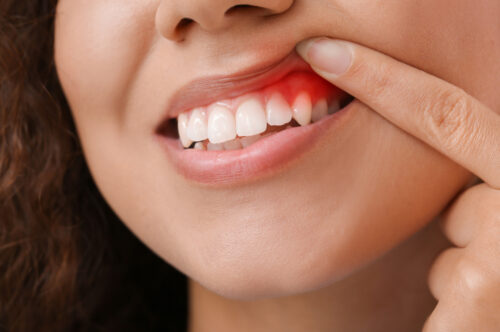Do you notice redness when you brush or floss? Have your gums started receding, exposing vulnerable tooth roots?
These seemingly minor oral health issues affect more adults than you might think. Ignoring them can have severe consequences like loose teeth, infections, costly procedures, and even tooth loss.
Gum disease impacts nearly half of adults over thirty in the US, although most don’t realize it. Early symptoms like tender gums after flossing seem harmless.
However, without treatment, gum disease progresses silently, damaging tissues and jawbone until teeth become loose or fall out. Catching gum disease early is the key to reversing damage and preventing tooth loss.
Keep reading to learn about the signs and symptoms of gum disease!
What is Gum Disease?
Gum disease, also called periodontal disease, is inflammation and infection of the gums and bone-supporting teeth. Left untreated, it can lead to loose teeth, bite issues, tooth loss, and bone loss. Gum disease starts with plaque buildup. Plaque is a sticky film of bacteria on teeth from food and drinks. If not removed by brushing and flossing, plaque hardens into tartar. Tartar below the gumline causes gum disease.
What Are the Stages of Gum Disease?
Gum disease has two stages: gingivitis and periodontitis.
Gingivitis
Gingivitis is mild gum inflammation, often from poor oral hygiene. Common signs include gums that appear red, swollen, or bleed when brushing. Though gingivitis itself does not cause permanent damage, ignoring these initial warning signs allows plaque and bacteria to advance below the gumline. With proper treatment and a consistent home care routine, gingivitis is reversible. Catching problems in the gingivitis stage protects your smile.
Symptoms of gingivitis include:
- Swollen, tender, red gums
- Bleeding when brushing/flossing
- Pink toothbrush after brushing
- Bad breath
Treating gingivitis can reverse symptoms and prevent progression to severe periodontitis. Treatment involves professional cleanings, resolving other dental issues, and diligent home care like brushing twice daily, daily flossing, and antiseptic mouthwash.
Periodontitis
Periodontitis is a serious gum infection damaging tissue and tooth structures. It results from untreated worsening gingivitis. This advanced stage of gum disease forms hardened plaque deposits, called calculus, on root surfaces below the gumline. Toxins from this buildup trigger chronic inflammation and infection, breaking down the tissues and bones that support teeth.
When you have advanced periodontitis, this decay of supporting fibers and bones can cause your teeth to become loose. The structural support weakens significantly, potentially leading to the need for tooth removal. By understanding these severe consequences, the importance of addressing periodontal disease promptly becomes clear.
The chronic inflammation and infection damage the gum tissue and progressively deteriorate the underlying bone structure. This underscores the critical need for effective dental care and intervention to prevent such outcomes.
Symptoms include those of gingivitis plus:
- Persistent bad breath
- Pus between teeth and gums
- Loose or lost teeth
- Painful chewing
- Black triangles between teeth
- Receding gums
- Misaligned bite
Unlike gingivitis, periodontitis causes irreversible damage.
What Treatments Are Available for Gum Disease?
Intensive treatment protects tooth, gum, and jawbone health. Treatments include:
Planing and Scaling
Removing plaque, tartar, and bacteria below gumlines and smoothing root surfaces to prevent further buildup. This helps gums reattach to teeth.
Antibiotics
Prescription anti-bacterial rinses, gels, or pills to control infections.
Referral to a Periodontist
Your dentist at Merry Dental might refer you to a gum disease specialist who can perform procedures like pocket reduction surgery, soft tissue grafts, and bone grafts to save natural teeth.
The best prevention is good oral hygiene and regular dental visits for early gum disease detection and treatment. This ensures your smile stays healthy long-term!
Are you noticing symptoms of gum disease? Schedule an appointment at Merry Dental in Billerica, MA, today!
How to Identify Healthy Gums
Wondering if your gums are in good shape? Here’s how to assess their health:
- Firmness: Touch your gums gently. Healthy gums should feel firm and stable. Soft or swollen areas might indicate an issue.
- Bleeding Check: After brushing or flossing, observe if there’s any bleeding. In healthy conditions, your gums should remain dry and free of blood.
- Color: Pay attention to color. Healthy gums are typically a light pink hue. Darker shades or redness could be a sign of irritation or infection.
- Fit: Examine how your gums meet your teeth. They should wrap snugly around each tooth, providing a secure seal without recession.
If any of the above criteria are not met, consider consulting a dental professional to ensure your smile remains bright and healthy.

